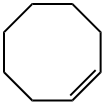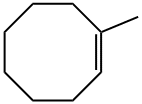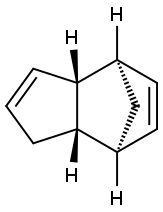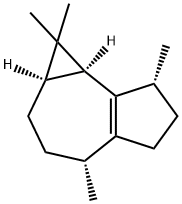CYCLOOCTENE
- CAS NO.:931-87-3
- Empirical Formula: C8H14
- Molecular Weight: 110.2
- MDL number: MFCD00001753
- EINECS: 213-243-4
- SAFETY DATA SHEET (SDS)
- Update Date: 2025-01-27 09:38:02

What is CYCLOOCTENE?
Chemical properties
clear colourless to light brown liquid
The Uses of CYCLOOCTENE
cis-Cyclooctene is used as a displaced ligand in chlorobis(cyclooctene)rhodium dimer and chlorobis(cyclooctene)iridium dimer in organometallic chemistry. It acts as a monomer used in synthetic chemistry. It is used to prepare 1-chloro-4-(trichloromethyl) cyclooctane by reaction with carbon tetrachloride using dichlorotris(triphenylphosphine) ruthenium(II) as a catalyst. Further, it is used to study the alkenes chemisorbed on silicon(100) by scanning tunneling microscopy.
Synthesis Reference(s)
Journal of the American Chemical Society, 102, p. 2693, 1980 DOI: 10.1021/ja00528a029
The Journal of Organic Chemistry, 40, p. 2555, 1975 DOI: 10.1021/jo00905a040
Tetrahedron Letters, 14, p. 2667, 1973
General Description
cis-Cyclooctene undergoes addition reaction with carbon tetrachloride catalyzed by dichlorotris(triphenylphosphine) ruthenium(II) to yield 1-chloro-4-(trichloromethyl) cyclooctane (1,4-adduct). It undergoes epoxidation catalyzed by molybdenum oxide nanoparticles incorporated in a mesoporous silica shell coated on dense silica-coated magnetite nanoparticles.
Purification Methods
The cis-isomer is freed from the trans-isomer by fractional distillation through a spinning-band column, followed by preparative gas chromatography on a Dowex 710-Chromosorb W GLC column. It is passed through a short alumina column immediately before use [Collman et al. J Am Chem Soc 108 2588 1986]. It has also been distilled in a dry N2 glove box from powdered fused NaOH through a Vigreux column (p 11), then passed through activated neutral alumina before use [Wong et al. J Am Chem Soc 109 4328 1987]. Alternatively it can be purified via the AgNO3 salt. This salt is obtained from crude cyclooctene (40 mL) by shaking at 70-80o with 50% w/w AgNO3 (2 x 15 mL) to remove cyclooctadienes (aqueous layer). Extraction is repeated at 40o (4 x 20 mL, of 50% AgNO3). Three layers are formed each time. The middle layer contains the AgNO3 adduct of cyclooctene which crystallises on cooling the layer to room temperature. The adduct (complex 2:1) is highly soluble in MeOH (at least 1g/mL) from which it crystallises in large flat needles when cooled at 0o. It is dried under slight vacuum for 1 week in the presence of CaCl2 and paraffin wax soaked in cyclooctene. It has m 51o and loses hydrocarbon on exposure to air. cis-Cyclooctene can be recovered by steam distillation of the salt, collected, dried (CaCl2) and distilled in vacuum. [Braude et al. J Chem Soc 4711 1957, AgNO3: Jones J Chem Soc 1808 1954, Cope & Estes J Am Chem Soc 72 1128 1950, Beilstein 5 I 35, 5 IV 263.] FLAMMABLE LIQUID.
Properties of CYCLOOCTENE
| Melting point: | −16 °C(lit.) |
| Boiling point: | 32-34 °C12 mm Hg(lit.) |
| Density | 0.848 g/mL at 20 °C(lit.) |
| vapor pressure | 9.9hPa at 20℃ |
| refractive index | n |
| Flash point: | 77 °F |
| storage temp. | Flammables area |
| solubility | H2O: insoluble |
| form | Liquid |
| color | Clear colorless to light brown |
| Water Solubility | Miscible with alcohol and ether. Immiscible with water. |
| Sensitive | Air Sensitive |
| BRN | 1280166 |
| CAS DataBase Reference | 931-87-3(CAS DataBase Reference) |
| EPA Substance Registry System | Cyclooctene, (1Z)- (931-87-3) |
Safety information for CYCLOOCTENE
| Signal word | Warning |
| Pictogram(s) |
 Flame Flammables GHS02  Health Hazard GHS08  Environment GHS09 |
| GHS Hazard Statements |
H226:Flammable liquids H304:Aspiration hazard H401:Hazardous to the aquatic environment, acute hazard H411:Hazardous to the aquatic environment, long-term hazard |
| Precautionary Statement Codes |
P210:Keep away from heat/sparks/open flames/hot surfaces. — No smoking. P303+P361+P353:IF ON SKIN (or hair): Remove/Take off Immediately all contaminated clothing. Rinse SKIN with water/shower. P405:Store locked up. |
Computed Descriptors for CYCLOOCTENE
New Products
4,4-Difluoropiperidine hydrochloride tert-butyl 9-methoxy-3-azaspiro[5.5]undecane-3-carboxylate Indole Methyl Resin N-Isopropylurea N,N-Dicyclohexylcarbodiimide(DCC) MELDRUMS ACID 5-METHYLISOXAZOLE-4-CARBOXYLIC ACID Magnessium Bis glycinate Zinc ascorbate 1-bromo-2-butyne 2-acetamidophenol 9(10H)-anthracenone Erythrosin B, 4-Piperidinopiperidine 2-((4-morpholinophenylamino) (methylthio) methylene) malononitrile 2,4-dihydroxybenzaldehyde 3-(4-morpholinophenylamino)-5-amino-1H-pyrazole-4-carbonitrile Methyl 2-methylquinoline-6-carboxylate 2,6-dichloro-4-nitropyridine 4-Bromo-2-chlorobenzonitrile 2-(benzylamino)acetic acid hydrochloride 4-(tert-Butoxycarbonylamino)but- 2-ynoic acid 3,4-dihydro-2H-benzo[b][1,4]dioxepine 1-Phenyl-1-cycloprppanecarboxylicacidRelated products of tetrahydrofuran








You may like
-
 Cis-cyclooctene 95% CAS 931-87-3View Details
Cis-cyclooctene 95% CAS 931-87-3View Details
931-87-3 -
 cis-Cyclooctene CAS 931-87-3View Details
cis-Cyclooctene CAS 931-87-3View Details
931-87-3 -
 3-(4-amino-1-oxoisoindolin-2-yl)-1-methylpiperidine-2,6-dione 98%View Details
3-(4-amino-1-oxoisoindolin-2-yl)-1-methylpiperidine-2,6-dione 98%View Details -
 614-19-7 98%View Details
614-19-7 98%View Details
614-19-7 -
 20677-73-0 (2,2-diethoxyethyl)methylamine 98%View Details
20677-73-0 (2,2-diethoxyethyl)methylamine 98%View Details
20677-73-0 -
 3-(4-(hydroxyamino)-1-oxoisoindolin-2-yl)piperidine-2,6-dione 98%View Details
3-(4-(hydroxyamino)-1-oxoisoindolin-2-yl)piperidine-2,6-dione 98%View Details -
 57381-49-4 2-bromo-4-chlorobenzonitrile 98%View Details
57381-49-4 2-bromo-4-chlorobenzonitrile 98%View Details
57381-49-4 -
 4,6-dichloropyrimidine-5-carbaldehyde 98%View Details
4,6-dichloropyrimidine-5-carbaldehyde 98%View Details
5305-40-8
